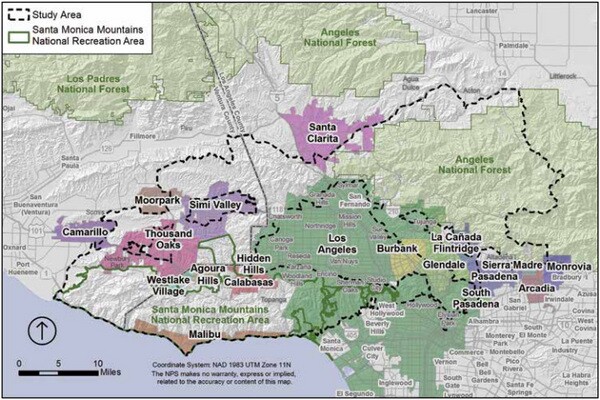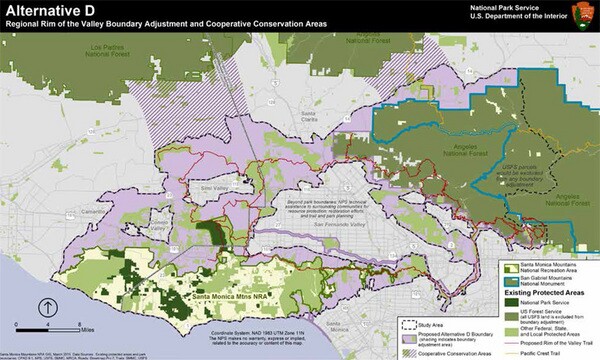Rim of the Valley Corridor Could Include L.A. River

The study has been five years in the making, but June 30 marks the light at the end of the tunnel for the Rim of the Valley Corridor Special Resource Study, which presents several options for incorporating some of the city's urban green destinations -- including the Los Angeles River corridor -- into the Santa Monica Mountains National Recreation Area (SMMNRA).
"[Expanding the Santa Monica Mountains Recreation Area] means that the National Park Service would be able to purchase land from willing sellers, engage in direct land management, spend money for trailhead improvements and provide public access to areas," says Anne Dove of the National Park Service's Pacific West Region. She was quick to negate any persistent concerns that any designation would allow the park service to exercise eminent domain on the designated areas -- the Park Service has an explicit policy of purchase from willing sellers, she says.
More on L.A. River Restoration and Ecology
Lobbied for by Congressman Adam Schiff, the Rim of the Valley study began in 2010, seeking to investigate the suitability of including adjoining areas to the Santa Monica Mountains Recreation Area. The study went through years of consideration with multiple points for public input: the first in 2010 at the start of the process; the second in 2012 and 2013 during the development of the four options that would expand the National Recreation Area in different ways; and finally, this year the final public comment period is currently under way until June 30, since a draft report was released to the public in April. The National Park Service is expected to release a final version of the report for consideration of Congress, late this year or early 2016.
Right now, the National Park Service can only do outreach and education outside of the SMMNRA boundary. They could also do research around natural cultural resources that relate to the Santa Monica Mountains, such as the current Cougar study which introduced the public to the famed P-22 lion of Griffith Park.

The study had its roots almost 50 years ago, when a California State University Northridge student, Marge Feinberg, rallied for a greenbelt of wildlife habitats, parks, and recreational areas around the San Fernando Valley. Her master's thesis, entitled the Rim of the Valley Parks, successfully captured the romance of interlocking green areas around Los Angeles.
After ruling out the possibility of setting up a new National Park in the study area, the study concentrated on identifying which exact areas would be incorporated into the SMMNRA. Four alternatives have been considered in the study. Alternative A would be a no-action option, which would leave everything as it is in the study area. Alternative B would allow for "cooperative conservation partnerships" without changing the current boundaries. Alternative C, which would add 173,000 acres, and Alternative D, which would add 313,000 acres, have gained the most support.
Both Alternatives C and D would include the Los Angeles River and Griffith Park. In a recent letter addressed to the agency, Schiff and representatives Reps. Judy Chu (D-Monterey Park), Tony Cardenas (D-San Fernando), Ted Lieu (D-Los Angeles), Brad Sherman (D-Sherman Oaks), Xavier Becerra (D-Los Angeles), and Lucille Roybal-Allard (D-Los Angeles) advocated for the larger Alternative D option, which includes additional land in the western portion of the study area, land north of the Angeles National Forest, and two wildlife corridors which would connect the study area to the Los Padres National Forest and to the northern portion of the Angeles National Forest.
"Since the public comment period has been open, the vast majority of my constituents have come out in support of the broadest possible preservation of these natural resources," said Schiff in a statement. "That's why we feel that Alternative C does not go far enough. My Los Angeles congressional delegation colleagues and I have joined together to support Alternative D -- a more expansive option that will provide for more connections between urban populations and nature and better wildlife habitat protection."

In explanation, Schiff said, "Los Angeles is among the rarest of America's large cities, with a significant urban population living in close proximity to nature. As Los Angeles has continued to grow, it has become increasingly apparent that unless action is taken to preserve open space, wildlife corridors, and the rare ecosystem around us, the natural beauty around us will disappear. Congress had the foresight in the 1970s to see this problem coming, and established the Santa Monica Mountains National Recreation Area. The only question is whether we can once again take action to preserve open space and wildlife habitats; if we cannot, they will be gone for good, and along with it, a lot of what we love about Los Angeles."
Should any of these two alternatives be recommended, the agency would focus on connecting people to parks, an important factor in public health, since it has been shown that increasing access to green areas also adds to the overall health of a city. The agency could also partner with the many organizations working on the river to develop projects that would benefit public access to the river and the growing number of parkways surrounding it.
Research done by Dr. Richard J. Jackson, who chairs the Environmental Health Sciences department at UCLA, also found that urban river parkways would offera wealth of health benefits at a fraction of the cost to treat medical conditions that would arise because of physical inactivity. Dr. Jackson's report highlights the finding that "every $1 investment in trails for physical activity leads to $2.94 in direct medical benefit." Another study cited notes that the cost per mile of bicycle and pedestrian trails is only between $83 and $592, whereas the annual cost per capita of physical inactivity is about $622.
Once this final round of public comments has finished, each comment will be considered by the agency in formulating its final report to be presented by the Secretary of Interior to Congress. Any implementation of the alternatives would require enabling congressional legislation. Any funding would also require funding appropriations. Congress can also choose not to take action on the report.
The agency is soliciting feedback on the report until June 30. Read more about the Rim of the Valley study here. Send your comments to pwr_rimofthevalley@nps.gov.





